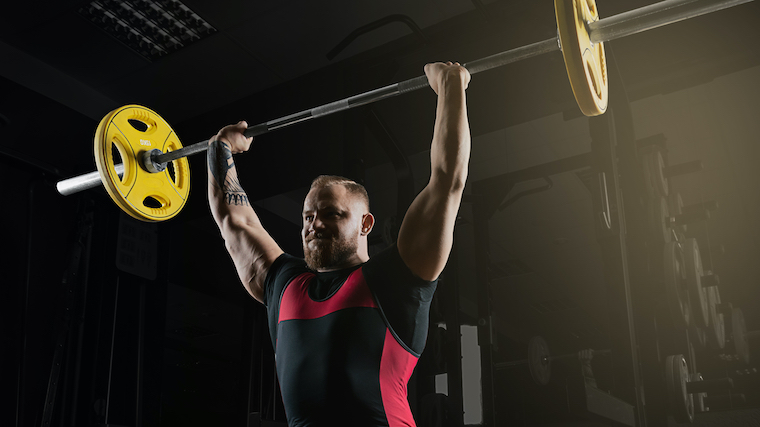It is often impressive to see a lifter pressing huge weights overhead (with good form), and should be a place of pride. The overhead press is a foundational compound movement that is great for building the upper body and a test of upper body stability.
You won’t get any assistance from the bench — with the overhead press, it’s your feet on the ground, your hands on the barbell, and you can either lift it or not. Today we are going to discuss how to perform it properly and why it should be a recurring part of your upper body training.
How To Overhead Press
Most athletes and lifters should incorporate an overhead press variation into their routine for overhead strength, power, and positive impact on other lifts and athletic performance. However, not everyone has the required shoulder mobility or core strength to perform an overhead press without compensations.
To check to see if you have any overhead mobility issues, watch the video below from Squat University:
[Related: 5 Overhead Exercises to Increase Shoulder Strength and Stability]
The overhead barbell press is an advanced movement and tough one for beginners to do well without prior instruction. An overhead press newbie should start with a dumbbell or landmine press variation which can be more forgiving on the wrists, elbows, and shoulders while working on good overhead mechanics.
[Related: Standing vs. Sitting Dumbbell Shoulder Press]
When you are ready for the barbell — don’t rush this, proper overhead mechanics are essential for this movement — here is how to set up your overhead press correctly:
- With the bar in front of you, place your hands just outside shoulder width apart.
- Keep elbows and forearms in a vertical position, stacked upon each other. If your elbows are tucked or flared, your grip is either too narrow or too wide. Please adjust accordingly.
- Place the bar on the heel of your palm — this is where most force will generate from.
- Make sure your middle knuckles face upwards (towards the ceiling).
Once you have all that down, be mindful not make any of the following mistakes when overhead pressing:
[Related: 3 Palloff Press Variations to Superset With Your Lifts]
Here are five undeniable benefits of the overhead press. Sorry, none of them are flexing, but feel free to add some in if you like.
1. Improved Core Strength
To prevent an excessive arch in the lower back or protruding rib cage when pressing overhead, your core needs to be strong. When doing any overhead press, the core should be taught throughout the entire movement. Using progressive overload when training the overhead press will not only strengthen your shoulders, but will improve your core stability and strength also.
2. Bigger Shoulders
The prime movers in the overhead press are the anterior and medial deltoids — posterior deltoids get some love too, as they are the stabilizers when the weight is overhead (a rare occurrence with upper body strength moves). More often, you can strengthen one or two but not all three at once.
If you want bigger, stronger, “boulder” shoulders, overhead pressing is necessary. Shoulder raise variations will only take your shoulder size and strength so far.
3. Better Bench Press Technique
A strong overhead press can help your bench press. Both movements use the same muscles (triceps, deltoids and chest) from different angles.

Additionally, upper back strength plays a larger role in overhead pressing. Strengthening the upper back can help you with the eccentric part of the bench press, reinforcing better bench technique.
4. Improved Lockout Strength And Power
Developing strength in your upper body increases your ability to create upper body power. A stronger muscle has an increased neural capacity (increased force production) — they a better chance at becoming a larger muscle also. However, to express power, you need to train it also. Strength sets the table for power.
With the triceps being one of the prime movers in the overhead press, increasing triceps strength and size can help improve lockout strength in other lifts that require an overhead position. For example, Olympic lifts, overhead carries, and overhead squats.
5. Real Life Carryover
No matter if you’re an athlete looking to improve performance or a lifter looking to get stronger, the core stability and strengthening benefits of the overhead press can help, but only if you perform it with good form. When avoiding hyperextension of the lower back, you’ll strengthen the erectors, obliques, rectus abdominis, and the deep core muscles.
Think about how many sports utilize overhead movements — swimming, baseball, softball, tennis, the quarterback in football, basketball, etc. Moving overhead or throwing requires core and overhead strength which the overhead press provides. It might sound obvious, but if you’re an overhead athlete, overhead pressing is a required move.
Wrapping Up
The overhead press has fantastic carryover for athletes who require strength in the overhead position and for other overhead lifts done in the gym. It helps build upper body strength, power, and flex appeal.
Ensure that you have learned correct overhead mechanics before moving anything heavy overhead. Make this movement a mainstay of your upper body training and reap its benefits in the gym and on the field.
Feature image via Andy Gin/Shutterstock.